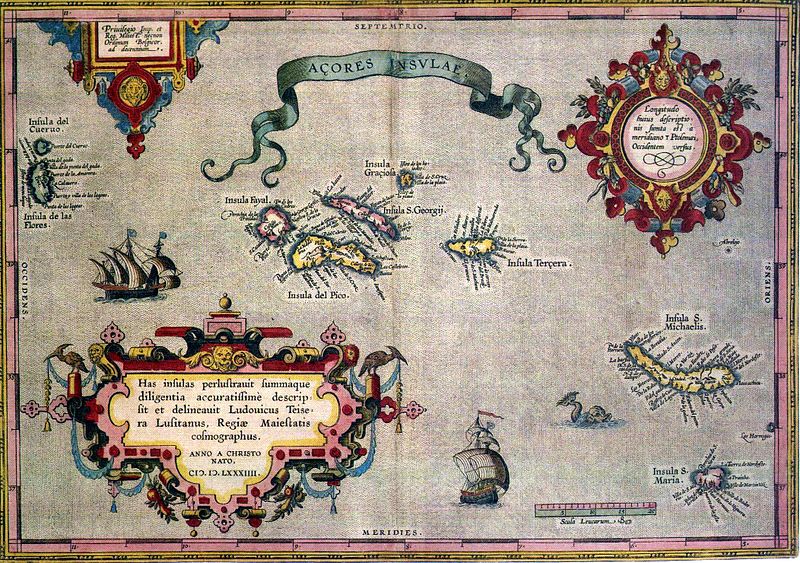History

Old map of the Azores Islands.
The islands were known in the fourteenth century and can be seen incompletely, for example, in the Atlas Catalan. In 1427, one of the captains sailing for Henry the Navigator rediscovered the Azores, possibly Gonçalo Velho, but this is not certain. The colonization of the then-unoccupied islands started in 1439 with people mainly from the continental provinces of Algarve and Alentejo; in the following centuries settlers from other European countries arrived, most notably from Northern France and Flanders. In 1583, Philip II of Spain as king of Portugal, sent his combined Iberian fleet to clear the French traders from the Azores, decisively hanging his prisoners-of-war from the yardarms and contributing to the "Black Legend". The Azores were the second-to-last part of the Portuguese empire to resist Philip's reign over Portugal (Macau being the last), Azores was returned to Portuguese control with the end of the Iberian Union, not by the military efforts, as these were already in Restoration War efforts in the mainland, but by the people attacking a well-fortified Castillian guarnition.
The 1820 civil war in Portugal had strong repercussions in the Azores. In 1829, in Vila da Praia, the liberals won over the absolutists, making Terceira Island the main headquarters of the new Portuguese regime and also where the Council of Regency (Conselho de Regência) of Mary II of Portugal was established.
Beginning in 1868, Portugal issued its stamps overprinted with "AÇORES" for use in the islands. Between 1892 and 1906, it also issued separate stamps for the three administrative districts of the time.
From 1836 to 1976, the archipelago was divided into three districts, quite equivalent (except in area) to those in the Portuguese mainland. The division was arbitrary, and didn’t follow the natural island groups, rather reflecting the location of each district capital on the three main cities (neither of each on the western group).
• Angra consisted of Terceira, São Jorge, and Graciosa, with the capital at Angra do Heroísmo on Terceira.
• Horta consisted of Pico, Faial, Flores, and Corvo, with the capital at Horta on Faial.
• Ponta Delgada consisted of São Miguel and Santa Maria, with the capital at Ponta Delgada on São Miguel.
During the Second World War, in 1943, the Portuguese dictator Salazar leased bases in the Azores to the British. This represented a change in policy. Previously the Portuguese government only allowed German U-boats and navy ships to refuel there.[1]. This was a key turning point in the Battle of the Atlantic, allowing the Allies to provide aerial coverage in the middle of the Atlantic. This helped them to hunt U-boats and protect convoys.
In 1944, American forces constructed a small and short-lived air base on the island of Santa Maria. In 1945, a new base was founded on the island of Terceira and is currently known as Lajes Field. It was founded in an area called Lajes, a broad, flat sea terrace that had been a farm. Lajes Field is a plateau rising out of the sea on the northeast corner of the island. This air force base is a joint American and Portuguese venture. Lajes Field has, and continues to support US and Portuguese military operations. During the Cold War, the US Navy P-3 Orion anti-submarine squadrons patrolled the North Alantic for Soviet submarines and surface spy vessels. Since its inception, Lajes Field has been used for refuelling aircraft bound for Europe, and more recently, the Middle East. The US Army operates a small fleet of military ships in the harbor of Praia da Vitória, three kilometers southeast of Lajes Field. The airfield also has a small commercial terminal handling scheduled and chartered passenger flights from other islands in the archipelago, Europe, and North America.
In 1976, the Azores became the Autonomous Region of the Azores (Região Autónoma dos Açores), one of the Autonomous regions of Portugal, and the Azorean districts were suppressed.
PoliticsSince becoming a Portuguese Autonomous Region, the executive section of the local authority has been located in Ponta Delgada, the legislative in Horta and the judicial in Angra do Heroísmo. The President of the Regional Government is Carlos César.
Azorean politics are dominated by the two largest Portuguese political parties - PSD and PS, the latter holding a majority in the Regional Legislative Assembly. The CDS/PP is also represented in the local parliament, in coalition with the PSD. Even though the PS dominates the administrative scene, the PSD is usually more popular in city and town council elections.
Current affairsIn 2003, the Azores saw international attention when U.S. President George W. Bush, British Prime Minister Tony Blair and then Spanish Prime Minister José María Aznar and then Portuguese Prime Minister José Manuel Durão Barroso held a summit there days before the commencement of the Iraq War.[2]
Municipalities
Pasture fields The Azores are divided into nineteen municipalities (concelhos); each municipality is further divided into parishes (freguesias). The Azores have a total of 156 parishes.
There are also five cities: Ponta Delgada and Ribeira Grande on São Miguel Island; Angra do Heroísmo and Praia da Vitória on Terceira, and Horta on Faial.
Angra
• Terceira
o Angra do Heroísmo and Vila da Praia da Vitória
• Graciosa
o Santa Cruz da Graciosa
• São Jorge
o Calheta and Velas
Horta
• Pico
o Lajes do Pico, Madalena and São Roque do Pico
• Faial
o Horta
• Flores
o Lajes das Flores and Santa Cruz das Flores
• Corvo
o Corvo
Ponta Delgada
• Santa Maria
o Vila do Porto
• São Miguel
o Lagoa, Nordeste, Ponta Delgada, Povoação, Ribeira Grande and Vila Franca do Campo